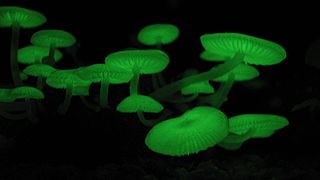
Amanita muscaria, commonly known as the fly agaric or fly amanita, is a basidiomycete of the genus Amanita. It is a large white-gilled, white-spotted, and usually red mushroom.

Hebeloma is a genus of fungi in the family Hymenogastraceae. Found worldwide, it contains the poison pie or fairy cakes (Hebeloma crustuliniforme) and the ghoul fungus (H. aminophilum), from Western Australia, which grows on rotting animal remains.

Hebeloma crustuliniforme, commonly known as poison pie or fairy cakes, is a gilled mushroom of the genus Hebeloma found in both Old and New World countries. It is moderately poisonous.
Hebeloma aminophilum, commonly known as the ghoul fungus, is a species of mushroom in the family Hymenogastraceae. Found in Western Australia, it gets its common name from the propensity of the fruiting bodies to spring out of decomposing animal remains.
Hebeloma dunense is a species of agaric fungus in the family Hymenogastraceae.

Hebeloma sinuosum is a species of agaric fungus in the family Hymenogastraceae. First described as Agaricus sinuosus by Elias Magnus Fries in 1838, it was later transferred to Hebeloma by Lucien Quélet in 1893. It is native to the United Kingdom.

Hebeloma radicosum, commonly known as the rooting poison pie, is a species of agaric fungus in the family Hymenogastraceae. Fruit bodies (mushrooms) can be identified by the tapering root-like stipe base, as well as the almond-like odor.
Hebeloma vinosophyllum is a toxic species of agaric fungus in the family Hymenogastraceae. The species was described by Japanese mycologist Tsuguo Hongo in 1965. It was recorded from Vietnamese Pinus kesiya forests in 2014, its first record in Southeast Asia.

Hebeloma vejlense is a species of agaric fungus in the family Hymenogastraceae. Discovered in Denmark growing on a lawn under Tilia, it was described as new to science in 2005.
Hebeloma vaccinum is a species of agaric fungus in the family Hymenogastraceae. It was described as new to science in 1965 by French mycologist Henri Romagnesi.

Hebeloma theobrominum is a species of agaric fungus in the family Hymenogastraceae. Described as new to science in 1987, it is found in Europe. It is the type species of Hebeloma section Theobromina, which includes H. alboerumpens, H. erumpens, H. griseopruinatum, H. parvicystidiatum, H. plesiocistum, and H. vesterholtii.

Coprinellus disseminatus, formerly known as Coprinus disseminatus and commonly known as the fairy inkcap, fairy bonnet, or trooping crumble cap, is a species of agaric fungus in the family Psathyrellaceae. Unlike most other coprinoid mushrooms, C. disseminatus does not dissolve into black ink (deliquesce) in maturity. The species was given its current name in 1939 by Jakob Emanuel Lange.
Ammonia fungi are fungi that develop fruit bodies exclusively or relatively abundantly on soil that has had ammonia or other nitrogen-containing materials added. The nitrogen materials react as bases by themselves, or after decomposition. The addition of ammonia or urea causes numerous chemical and biological changes, for examples, the pH of soil litter is increased to 8–10; the high alkaline conditions interrupts the process of nutrient recycling. The mechanisms of colonization, establishment, and occurrence of fruiting bodies of ammonia fungi has been researched in the field and the laboratory.

Amanita regalis, commonly known as the royal fly agaric or the king of Sweden Amanita, is a species of fungus in the family Amanitaceae. A. regalis has a scabby liver-brown cap and a stem which is yellow-ochre at the base, with patches or rings of patches. The fruit bodies somewhat resemble the smaller A. muscaria, which it was formerly regarded as a variety of.

Mycena chlorophos is a species of agaric fungus in the family Mycenaceae. First described in 1860, the fungus is found in subtropical Asia, including India, Japan, Taiwan, Polynesia, Indonesia, and Sri Lanka, in Australia, and Brazil. Fruit bodies (mushrooms) have pale brownish-grey sticky caps up to 30 mm (1.2 in) in diameter atop stems 6–30 mm (0.2–1.2 in) long and up to a millimeter thick. The mushrooms are bioluminescent and emit a pale green light. Fruiting occurs in forests on fallen woody debris such as dead twigs, branches, and logs. The fungus can be made to grow and fruit in laboratory conditions, and the growth conditions affecting bioluminescence have been investigated.
Hebeloma moseri is a species of agaric fungus in the family Hymenogastraceae. Found in Argentina, it was described as new to science by mycologist Rolf Singer in 1969. The specific epithet moseri honors Austrian mycologist Meinhard Moser.

Amanita chrysoblema, with the common name American fly agaric, white variant, is a basidiomycete fungus of the genus Amanita. Although named chrysoblema, it is traditionally thought to be an Amanita muscaria variant, a group of fungi commonly known as fly agarics.

Termitomyces eurrhizus species of agaric fungus in the family Lyophyllaceae native to Pakistan, India, Sri Lanka, Burma, southwestern China and Malaysia. The fungus has a symbiotic relationship with termites, its mushrooms growing out of mounds after periods of rainfall. It is eaten in Malaysia and the Indian subcontinent.
Amanita rimosa is a species of agaric fungus in the family Amanitaceae native to Hunan, first described by P. Zhang & Zhu L. Yang in 2010. Like other Phalloideae amanitas, it is lethally toxic. A distinctive feature of A. rimosa is its rimose pileus, caused by slightly gelatinized upper layer of the pileipellis, which is a rare structure among other Amanita species.











